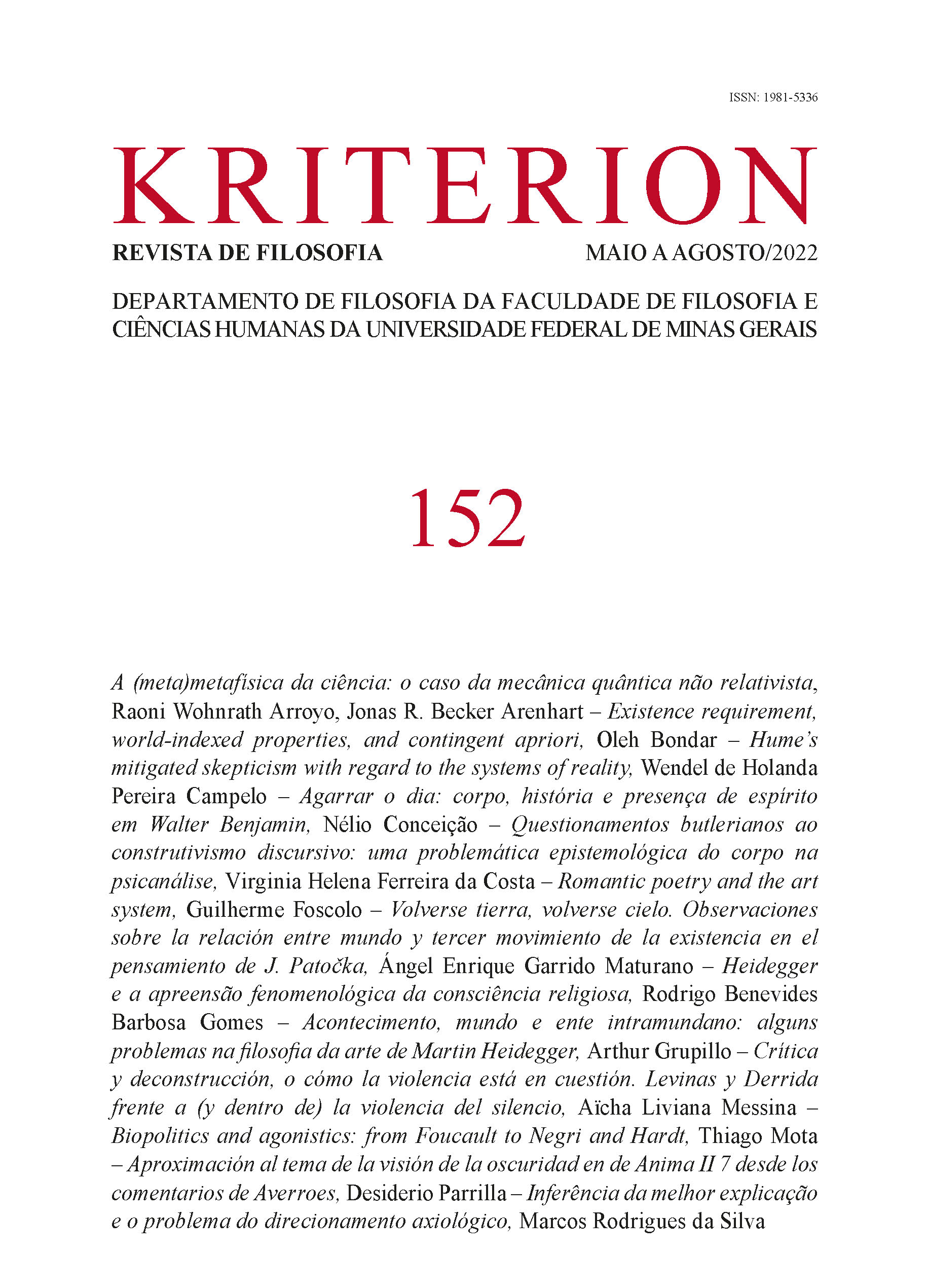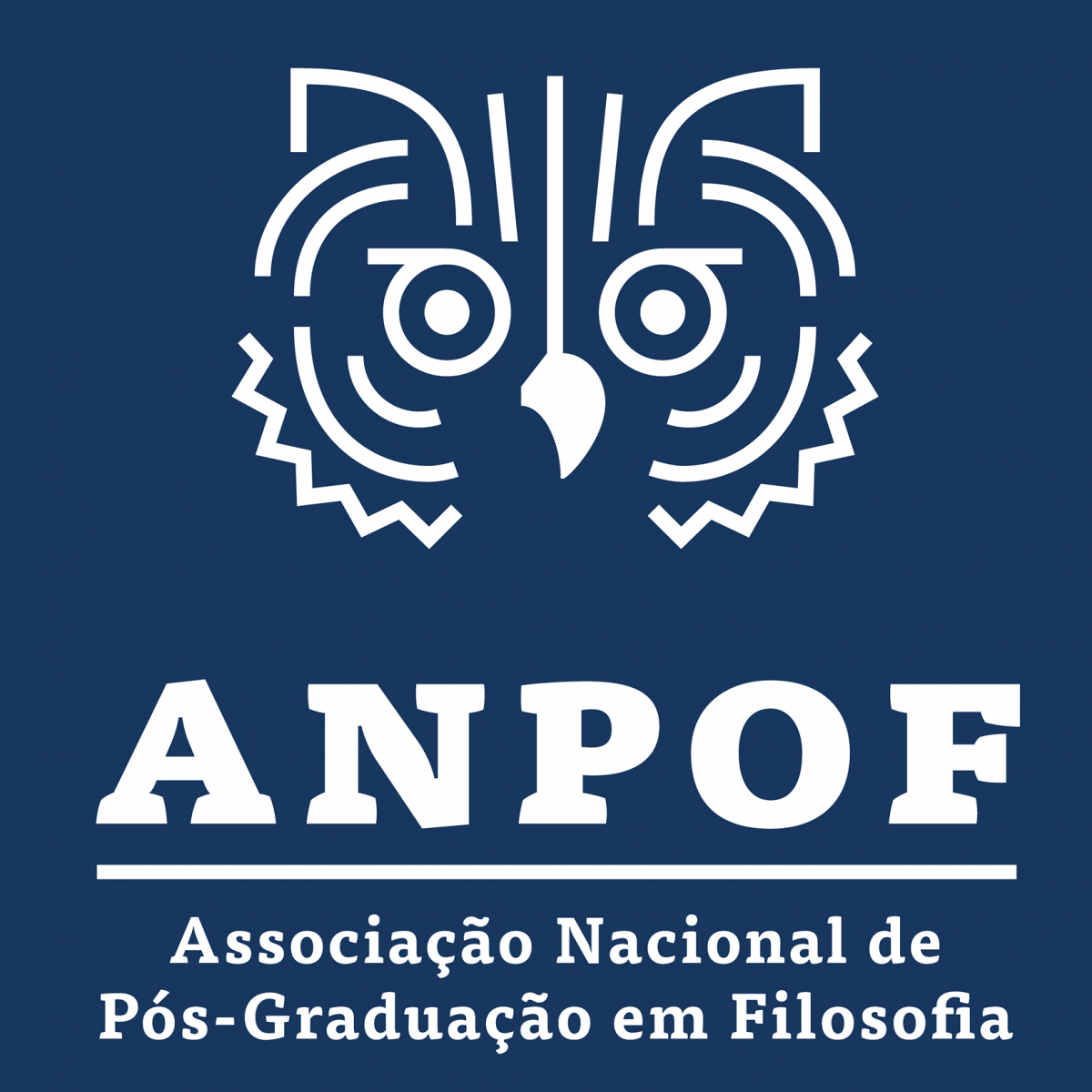SEIZING THE DAY:
BODY, HISTORY AND PRESENCE OF MIND IN WALTER BENJAMIN
Keywords:
Presence of mind, Body, History, Experience of shock, Danger, AestheticsAbstract
This article focuses on the role that the concept of “presence
of mind” (Geistesgegenwart) plays in Walter Benjamin’s thought, deepening
lines of interpretation that are connected to other relevant concepts such as
“attention” (Aufmerksamkeit) and “now-time” (Jetztzeit). It examines elements
of Benjamin’s work that develop the philosophical importance of presence
of mind, emphasizing its corporeal dimension and its aesthetic and critical
relevance. The analysis covers five lines of interpretation that intersect in
different ways: (i) presence of mind is a form of thought/action that should be
cultivated as a way of dealing with the experience of shock; (ii) having presence
of mind is an attitude that can be exercised; (iii) “seizing the day” involves
the body and presupposes an experience of intensive time; (iv) the conceptual
framework of presence of mind integrates elements related to play; and (v) by
valuing the present, presence of mind implies a relationship between danger
and a critical gesture – in Benjamin’s historical and political reflection, this
gesture intertwines the individual and the collective dimensions.
References
AGAMBEN, G. “Infância e história: destruição da experiência e origem da história”. Trad. H. Burigo. Belo Horizonte: Editora UFMG, 2014.
BAUDELAIRE, C. “As Flores do Mal”. Trad. F. P. Amaral. Lisboa: Assírio e Alvim, 1998.
BENJAMIN, W. “A modernidade”. Trad. J. Barrento. Lisboa: Assírio e Alvim, 2006.
______. “A obra de arte na época da sua possibilidade de reprodução técnica” (terceira versão). (2006a). In: W. Benjamin, 2006, pp. 207-241.
______. “A obra de arte na época de sua reprodutibilidade técnica” (segunda versão). Trad. F. P. Machado. Porto Alegre: Zouk, 2014.
______. “A Paris do Segundo Império na Obra de Baudelaire”. (2006b). In: W. Benjamin, 2006, pp. 9-102.
______. “As passagens de Paris”. Trad. J. Barrento. Lisboa: Assírio e Alvim, 2019.
______. “Ensaios sobre literatura”. Trad. J. Barrento. Lisboa: Assírio e Alvim, 2016.
______. “Gesammelte Schriften”. Vols. I-VII. Ed. R. Tiedemann e H. Schweppenhäuser. Frankfurt am Main: Suhrkamp, 1991.
______. “Imagens de pensamento”. (2004a). In: W. Benjamin, 2004, pp. 123-258.
______. “Imagens de pensamento”. Trad. J. Barrento. Lisboa: Assírio e Alvim, 2004.
______. “O anjo da história”. Trad. J. Barrento. Lisboa: Assírio e Alvim, 2010.
______. “Para um retrato de Proust”. (2016a). In: W. Benjamin, 2016, pp. 312-328.
______. “Rua de sentido único”. (2004b). In: W. Benjamin, 2004, pp. 7-69.
______. “Sobre alguns motivos na obra de Baudelaire”. (2006c). In: W. Benjamin, 2006, pp. 103-148.
______. “Sobre o conceito da História”. (2010a). In: W. Benjamin, 2010, pp. 9-20.
DUTTLINGER, C. “Between Contemplation and Distraction: Configurations of Attention in Walter Benjamin”. German Studies Review, Vol. 30, No. 1, 2007, pp. 33-54.
ESPINOSA, B. de “Ética”. Trad. D. P. Aurélio. Lisboa: Relógio D’Água, 2020.
FOUCAULT, M. “Dits et Écrits (vol. IV: 1980-1988)”. Paris: Gallimard, 1994.
______. “Qu’est-ce que les lumières?”. (1994a). In: M. Foucault, 1994, pp. 562-578.
FRANCE, A. “Le jardin d’Épicure”. Paris: Calmann Lévy, 1895.
GAGNEBIN, J. M. “Atenção e dispersão: elementos para uma discussão sobre arte contemporânea a partir de Adorno e Benjamin”. (2014a). In: J. M. Gagnebin, 2014, pp. 99-119.
______. “História e Narração em Walter Benjamin”. São Paulo: Perspectiva/FAPESP; Campinas SP: UNICAMP, 1994.
______. “Limiar, aura e rememoração”. São Paulo: Editora 34, 2014.
GILLOCH, G. “Myth and Metropolis: Walter Benjamin and the City”. Oxford: Polity Press, 1997.
LISKA, V. “Walter Benjamin’s Dialectics of Attentiveness”. Symposium: A Quarterly Journal in Modern Literatures, Vol. 65, No. 1, 2011, pp. 16-24.
MACHADO, F. P. “Imagem e consciência da história: pensamento figurativo em Walter Benjamin”. São Paulo: Edições Loyola, 2013.
MENKE, B. “Sprachfiguren: Name – Allegorie – Bild nach Walter Benjamin”. München: Fink Verlag, 1991.
MOLDER, M. F. “O Químico e o Alquimista. Benjamin, leitor de Baudelaire”. Lisboa: Relógio D’Água, 2011.
NITSCHE, J. “Walter Benjamins Gebrauch der Fotografie”. Berlim: Kadmos, 2010.
OPITZ, M., WIZISLA, E (eds.). “Benjamins Begriffe”. Frankfurt am Main: Suhrkamp, 2000.
RICHTER, G. “Walter Benjamin and the Corpus of Autobiography”. Detroit: Wayne State University Press, 2000.
SIMMEL, G. “As Metrópoles e a Vida Mental”. (2004a). In: G. Simmel, 2004, pp. 75-94.
______. “Fidelidade e Gratidão e Outros Textos”. Trad. M. J. C. Pereira e M. Knoch. Lisboa: Relógio D’Água, 2004.
SYMONS, S. “Walter Benjamin, Presence of Mind, Failure to Comprehend”. Leiden/ Boston: Brill, 2013.
WAIZBORT, L. “As aventuras de Georg Simmel”. São Paulo: Editora 34, 2000.
WEBER, T. “Erfahrung”. (2000a). In: M. Opitz und E. Wizisla (eds.), 2000, pp. 230-259.
WEIDMANN, H. “Geistesgegenwart: Das Spiel in Walter Benjamin’s Passagenarbeit”. MLN, Vol. 107, No. 3, 1992, pp. 521-547.
WEIGEL, S. “Body-and image-space. Re-reading Walter Benjamin”. Trad. G. Paul, R. McNicholl and J. Gaines. London: Routledge, 1996.
Downloads
Published
Issue
Section
License
Copyright (c) 2022 Revista Kriterion

This work is licensed under a Creative Commons Attribution 4.0 International License.










